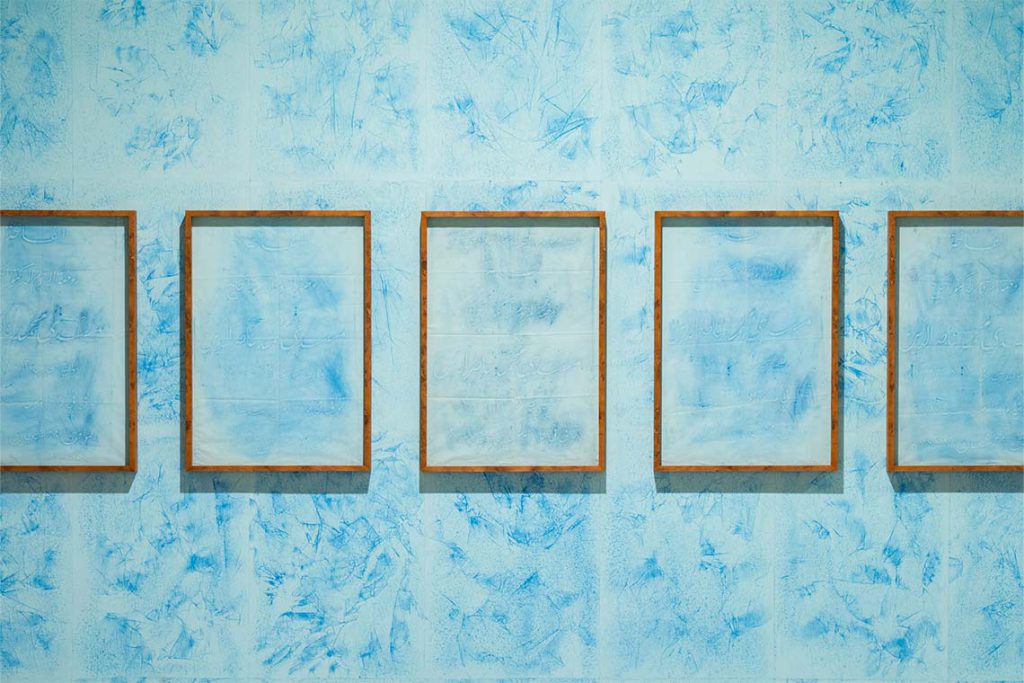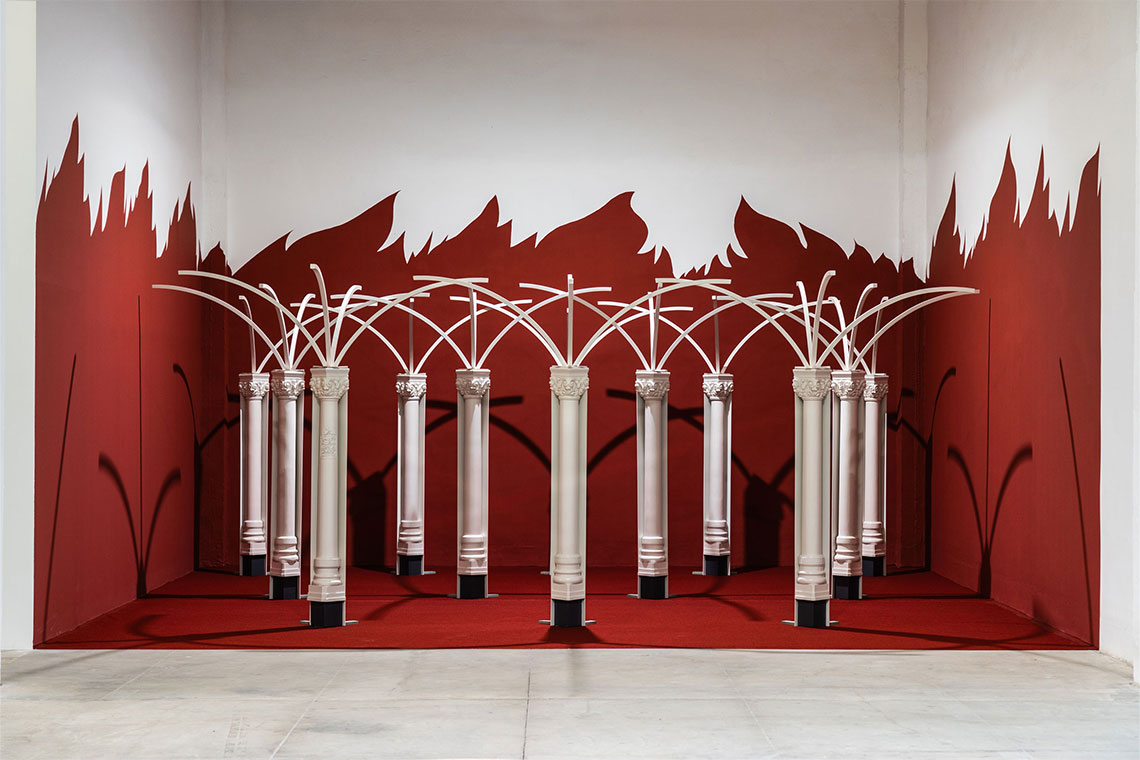Hussein Nassereddine’s current exhibition weaves together personal narratives, history, poetry and a touch of surrealism, with time as the unifying force.
Lebanese artist Hussein Nassereddine often explores the intersection between poetry, history and contemporary art, following a somewhat academic approach to themes that are rooted in personal narratives and collective consciousness. His current solo show at Beirut Art Center, Years Of The Shining Face, is a thought-provoking culmination of his many interests and presents a profound investigation of time and memory through the lens of language, song, literature and his own history.
“The genesis of the show is looking at the different temporalities that might exist,” Nassereddine tells Canvas. The show opens with a verse from the Qur’an that says “But a day of God’s days is indeed like a thousand years by your counting” (Surat Al-Hajj, 47), something that resonated with the artist. “I was particularly interested in the idea of shifting temporalities and the possibility of time unfolding in a way that could explain how something seemingly impossible might happen – something suddenly appearing or changing,” he explains.
“It’s an alternate way of thinking about how time, geography and history can affect language, but also can affect things materially,” he adds. “In the works, I superimpose references from religious texts, pop songs from the Golden Age of Arab pop, folktales and myths, personal stories from my family, as well as Arabic poetry, especially those that describe architectural monuments and ruins. There is this juxtaposition of all these sources and references, placed against one another, which starts seeping into the works themselves.”
Through sound, installation, video, text and sculptural works, Nassereddine creates a liminal space where past and present converge. Of the two main installations, You Were Right, O Heart (2025) draws on poetry and song across the ages to explore how music can transcend time; it takes the form of a makeshift theatre, something that was wildly popular in the Arab world during the 1980-90s.

Created specifically for the BAC show, the architectural space – made from mirrored surfaces, dark wood and burgundy red curtains – instantly takes visitors back to old-age performance spaces and the magical suspension of disbelief that they represent. “I always thought of them as liminal spaces and the idea of the singers entering time, with their voice becoming part of a lineage or history, and then merging with other temporalities through performance,” the artist says. In the middle of this theatre, there is a plaque that has a poem on it, translating roughly to ‘Had the dawn been delayed for a second, we would have survived, but death.’ “The dawn here comes as a reminder that it always has two faces, being both the beginning of the day and the end of the night,” Nassereddine explains.
The second installation, The Palm Tree Forest (2025), is a visual representation of a recurring symbol in Arabic poetry and folktales. It refers to poets describing palm trees and pillars, and so Nassereddine has created a forest of white Corinthian columns with arched poles on top, like palm fronds. Intended to resemble stage background props, the installation ties in his thoughts on theatres as liminal spaces. The work draws from the story of Abd Al-Rahman the Entrant (731–88 AD), the first Arab ruler of Andalusia and who, after 30 years in exile, is said to have died instantly upon seeing a palm tree. The white columns are set against a blood-red backdrop of flames, evoking catastrophes and burning skies, something otherworldly, like the end of days.

“The history books don’t account for why or how this palm tree appeared – because palm trees are not native to Cordoba – or how someone could die just from seeing a palm tree,” Nassereddine says. “I was interested in the idea of sight killing the beholder, and of this palm tree as an object outside of time. Maybe those 30 years away from home didn’t really happen until that moment when he saw the palm tree. If you follow the logic of one day equalling 1000 years, then three decades condensing into one second, the second of beholding the palm tree, become something that could kill someone.”
Many of the other works in the exhibition have references to water and rivers, but also touch on rethinking the destruction of Nassereddine’s ancestral village of Sejoud in southern Lebanon, which was razed by Israeli forces between the 1980s and 2000. Drawing on Arabic poetry from the sixth century onwards, A Few Decent Ways to Drown(2022) explores the fragile relationship between poetry, water and time. The stone fountain, with a floral shape that recalls ornamental water features once found across cities, courtyards and palaces throughout the region – are now only preserved through mentions in poems and texts.
The fountain’s blue surface is made of archival carbon papers found tucked away between the pages of his father’s poetry books, retaining notes and observations. Exposure to the sun over time has altered the paper’s colour and texture. River Papers (2024) replicates this technique, with Nassereddine creating seven carbon paper rubbings from his father’s grave at different times, capturing a particular moment of emotion in time.
“My father was an ontologist and scholar of Arabic poetry,” Nassereddine explains. “He would gather complete poems from a certain period, or from a certain poet, and like many scholars of the time he would use this blue carbon paper, because it allowed them to keep copies of the notes that they would write on the poetry. Years after his death, I opened one of the notes to discover that the carbon on it had disappeared because of age, and that the edges coming out of the books had been exposed to the sun, leaving new traces and marks.”
For Nassereddine, all that is lost comes back in a different form, with the poetry passing from one narrator to another and embodied in the abstracts and drawings. “My father’s life and death have also become carbon notes and annotations on poetry, so it kind of makes a full circle,” he observes.
Years Of The Shining Face is a contemplative invitation to think of time as non-linear and what that could mean for our memories and how our lives can be shaped by events from the past. To bring a more tangible understanding to viewers, a series of performances will be programmed throughout the exhibition’s run, staging music shows inside the theatre installation and activating the space for an immersive experience.



